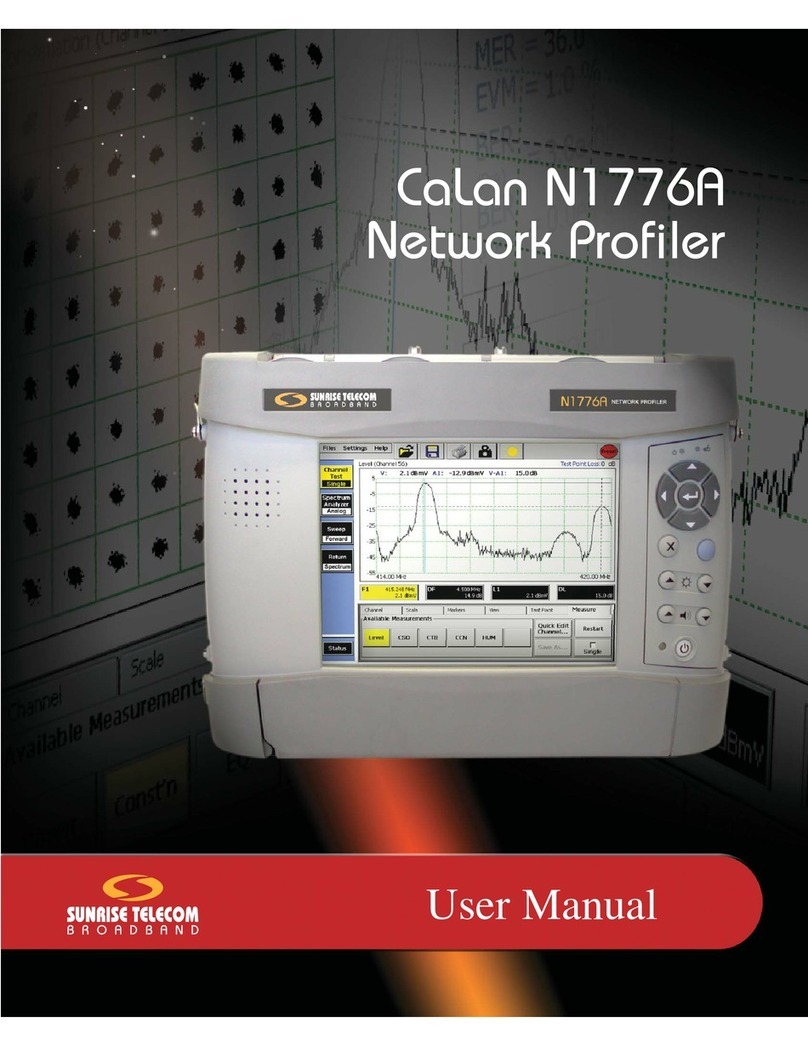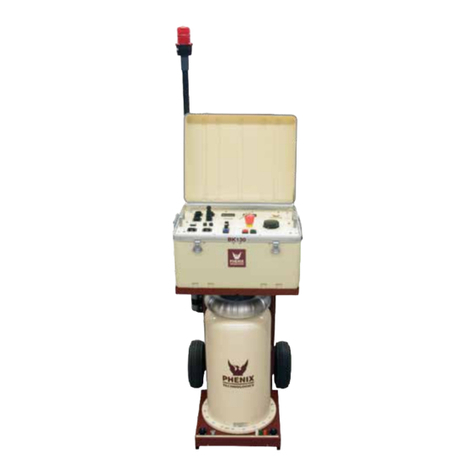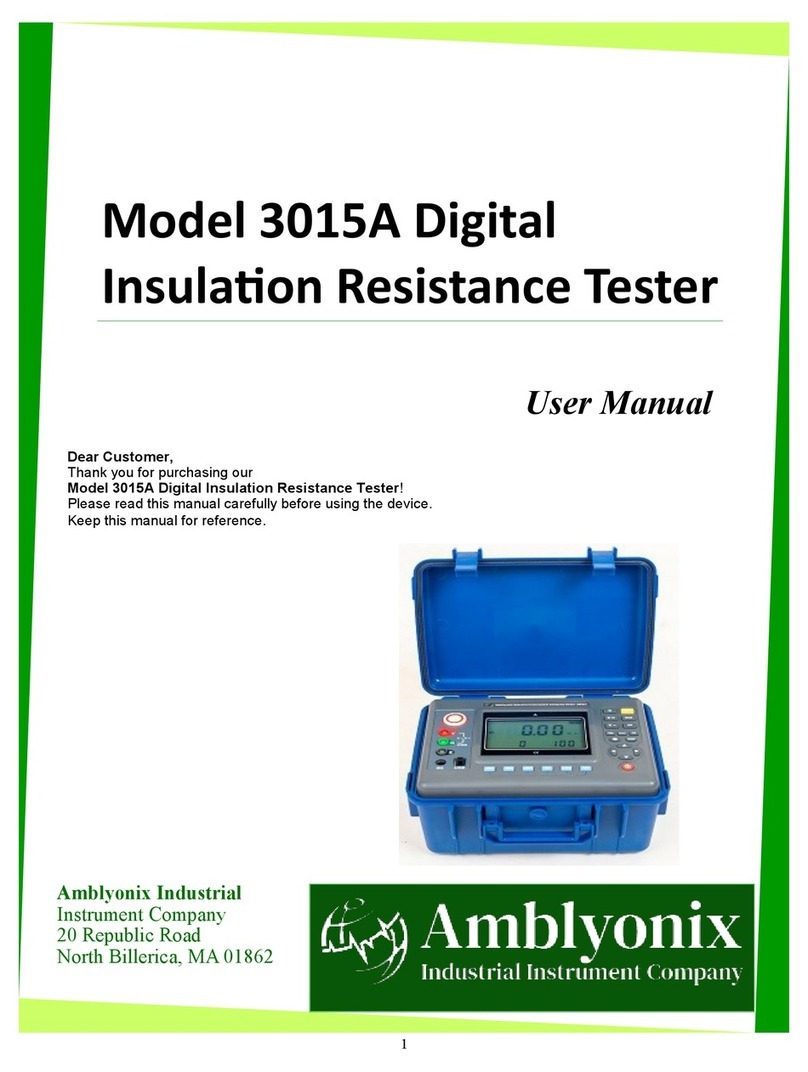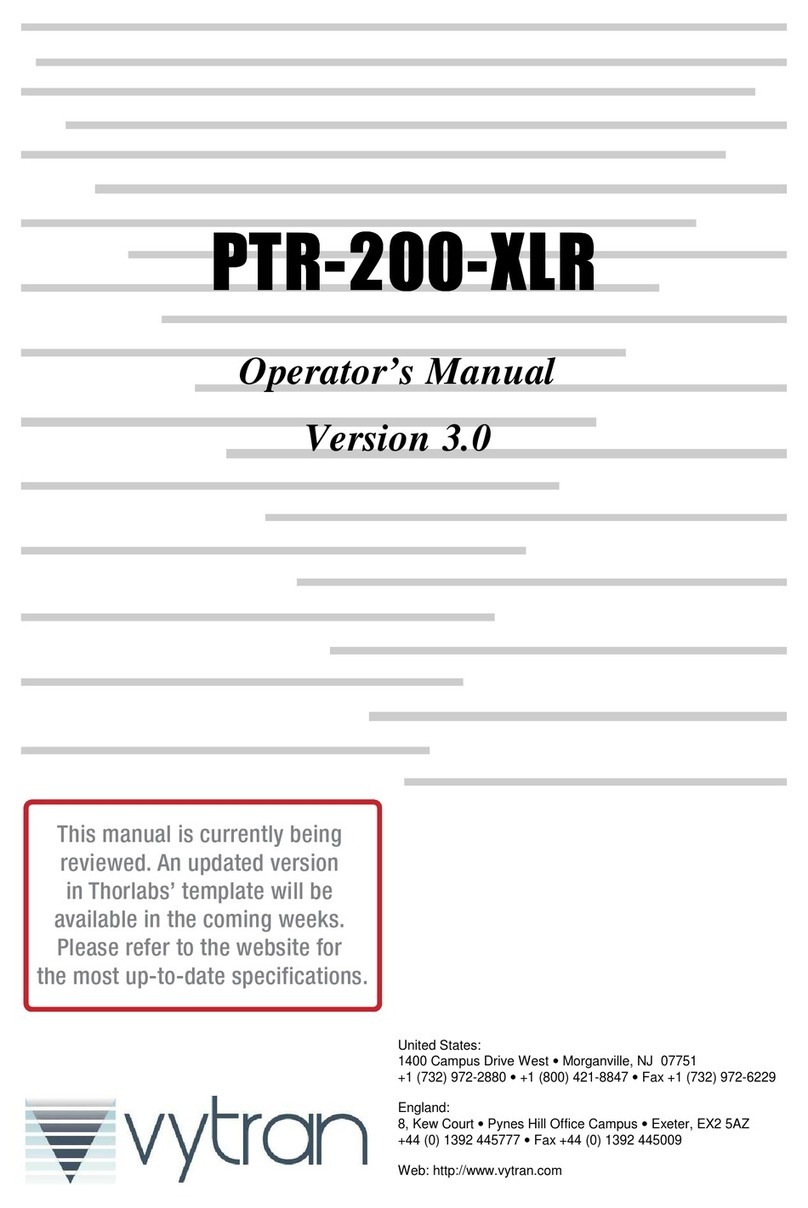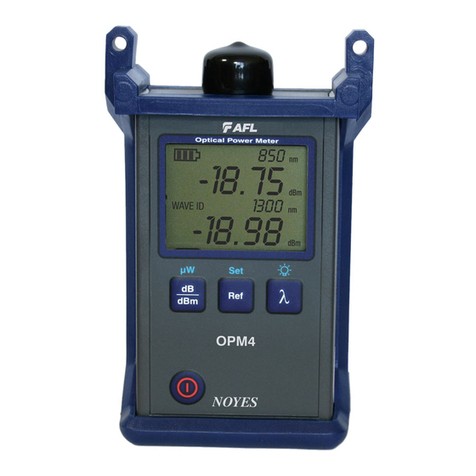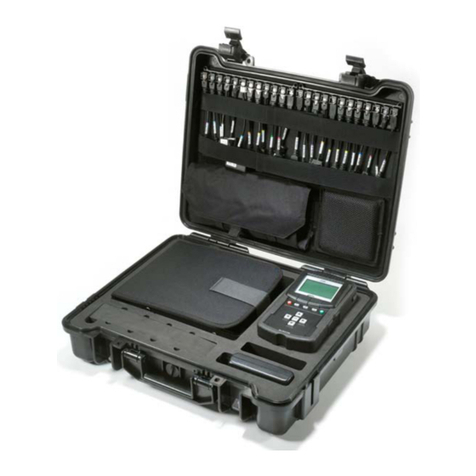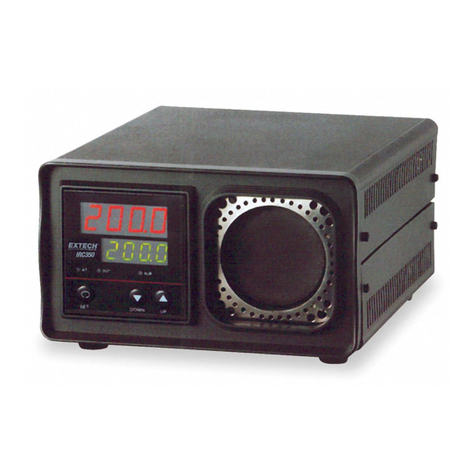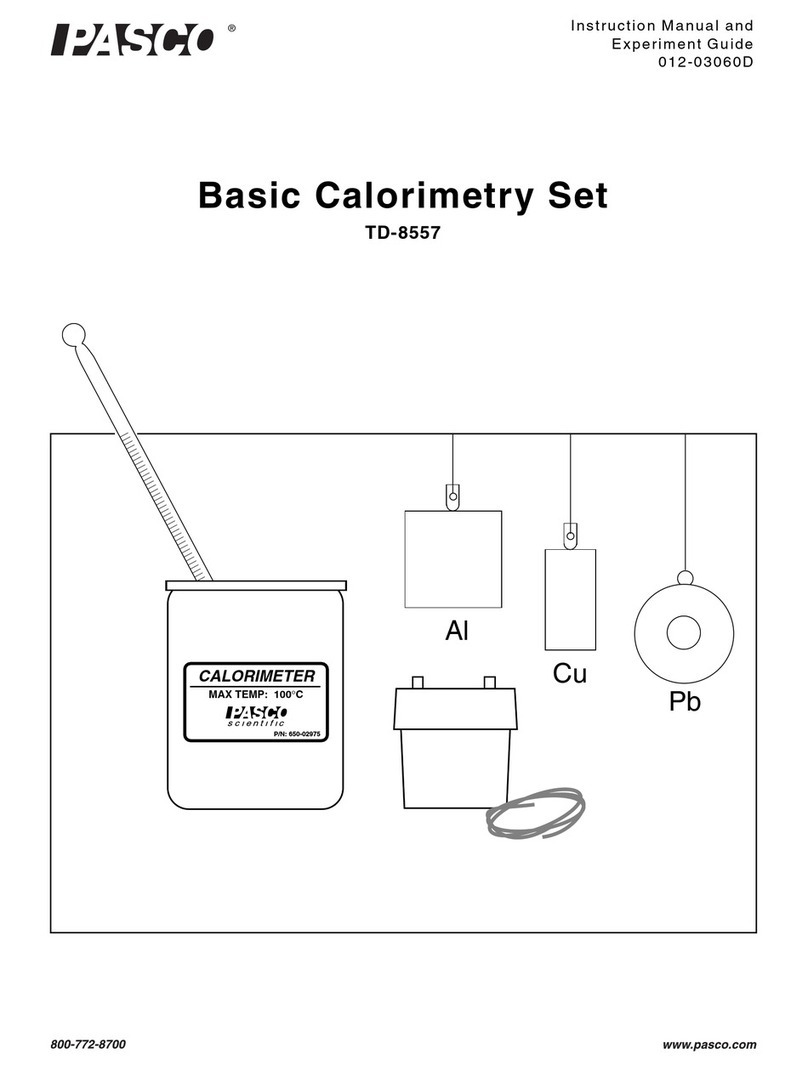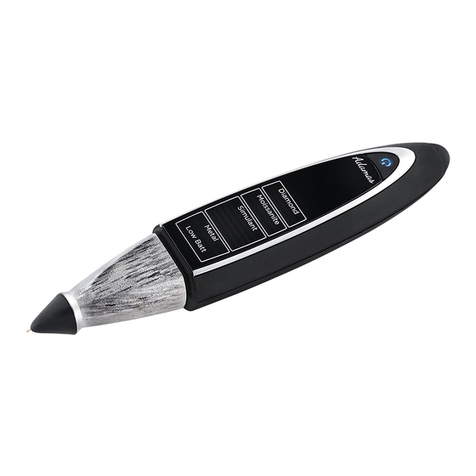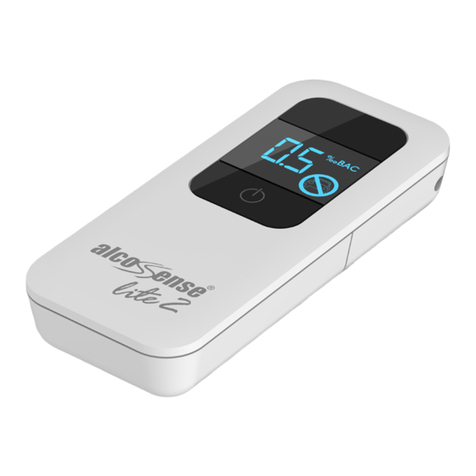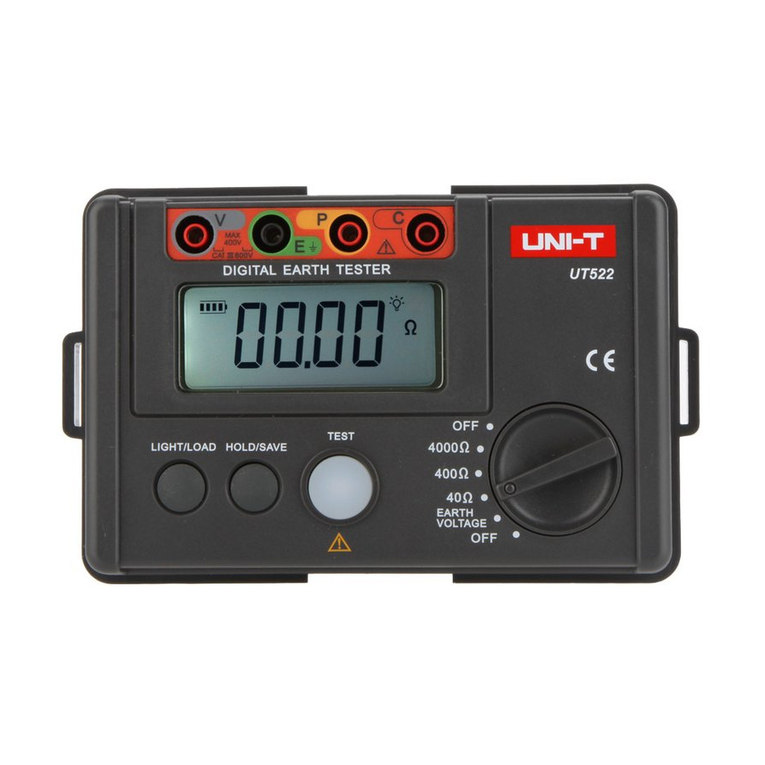Sourcetronic ST2883-5 User manual

ST2883 Series Operation Manual
1
OperationManual
MODELST2883‐5/ ‐10
ImpulseWindingTester
S
S
So
o
ou
u
ur
r
rc
c
ce
e
et
t
tr
r
ro
o
on
n
ni
i
ic
c
c
G
G
Gm
m
mb
b
bH
H
H
Fahrenheitstraße1
28359Bremen
Germany
TEL:+494212779999
FAX:+494212779998
info@sourcetronic.com
www.sourcetronic.com

ST2883 Series Operation Manual
2
Contents
Chapter 1 Overview................................................................................................................ 1-1
1.1 Production introduction................................................................................................. 1-1
1.2 Operation environment.................................................................................................. 1-2
1.2.1 Power supply....................................................................................................... 1-2
1.2.2 Environment temperature and humidity ............................................................. 1-2
1.2.3 Warm-up ............................................................................................................. 1-3
1.3 Dimensions and weight ................................................................................................. 1-3
Chapter 2 General specifications............................................................................................ 2-1
2.1 Specifications ................................................................................................................ 2-1
2.2 Comparison methods..................................................................................................... 2-2
2.2.1 Area size comparison .......................................................................................... 2-2
2.2.2 Differential area comparison............................................................................... 2-2
2.2.3 Corona discharge comparison............................................................................. 2-3
2.2.4 Differential phase comparison ............................................................................ 2-3
Chapter 3 Panels and display.................................................................................................. 3-1
3.1 Front panel .................................................................................................................... 3-1
3.2 Rear panel...................................................................................................................... 3-3
3.3 Introduction to display area........................................................................................... 3-4
Chapter 4 Introduction to [DISP] ........................................................................................... 4-1
4.1 Measurement display page ............................................................................................ 4-1
4.2 Introduction to symbols in measurement display page ................................................. 4-1
4.3 Introduction to soft keys in measurement display page ................................................ 4-2
4.3.1 Standard sampling............................................................................................... 4-2
4.3.2 Compare.............................................................................................................. 4-4
4.3.3 Measure............................................................................................................... 4-4
4.3.4 Utility.................................................................................................................. 4-5
4.3.5 Statistics .............................................................................................................. 4-5
4.3.6 Modify ................................................................................................................ 4-5
Chapter 5 Introduction to [SETUP]........................................................................................ 5-1
5.1 Introduction to icons of soft keys .................................................................................. 5-1
5.2 Measurement setup page ............................................................................................... 5-1
5.2.1 Imp Volt .............................................................................................................. 5-2
5.2.2 Samp ................................................................................................................... 5-2
5.2.3 Test Imp .............................................................................................................. 5-2
5.2.4 Erase Imp ............................................................................................................ 5-2
5.2.5 Volt ADJ.............................................................................................................. 5-3
5.2.6 Wave Disp........................................................................................................... 5-3
5.2.7 Trig Mode ........................................................................................................... 5-3
5.2.8 Delay Time.......................................................................................................... 5-4
5.2.9 BDV Test ............................................................................................................ 5-4
5.2.10 Start Volt ........................................................................................................... 5-4
5.2.11 End Volt............................................................................................................. 5-4
5.2.12 Volt Step............................................................................................................ 5-5

ST2883 Series Operation Manual
3
5.2.13 Comparator ....................................................................................................... 5-5
5.2.14 Position (AREA SIZE, DIFF ZONE, PHASE DIFF) ....................................... 5-5
5.2.15 Position(PHASE DIFF)............................................................................... 5-5
5.2.16 DIFF(Limit)(AREA SIZE, DIFF ZONE, PHASE DIFF)......................... 5-6
5.2.17 DIFF(Limit)(CORONA).......................................................................... 5-6
5.3 Int. File .......................................................................................................................... 5-6
5.4 Ext. File ......................................................................................................................... 5-8
Chapter 6 Introduction to [SYSTEM] .................................................................................... 6-1
6.1 System ........................................................................................................................... 6-1
6.1.1 Brightness ........................................................................................................... 6-1
6.1.2 Pass/Fail.............................................................................................................. 6-2
6.1.3 Pass Alarm .......................................................................................................... 6-2
6.1.4 Fail Alarm ........................................................................................................... 6-2
6.1.5 Key Sound........................................................................................................... 6-2
6.1.6 Hard Copy........................................................................................................... 6-2
6.1.7 Password ............................................................................................................. 6-2
6.1.8 Language............................................................................................................. 6-3
6.1.9 Theme ................................................................................................................. 6-3
6.1.10 Date................................................................................................................... 6-3
6.1.11 Time .................................................................................................................. 6-3
6.2 Interface......................................................................................................................... 6-4
6.2.1 I/O ....................................................................................................................... 6-4
6.2.2 ST2883 RS232C interface .................................................................................. 6-4
6.2.3 USB interface...................................................................................................... 6-6
6.2.4 LAN interface ..................................................................................................... 6-9
6.3 About........................................................................................................................... 6-11
Chapter 7 User guide.............................................................................................................. 7-1
7.1 Use of keys.................................................................................................................... 7-1
7.1.1 Use of the roller .................................................................................................. 7-1
7.1.2 Switch the display page ...................................................................................... 7-1
7.1.3 Numeric arrow key ............................................................................................. 7-1
7.2 Basic measurement........................................................................................................ 7-1
7.2.1 Non-standard test ................................................................................................ 7-1
7.2.2 Sample test for standard wave ............................................................................ 7-2
7.3 BDV test........................................................................................................................ 7-2
7.4 Technology application ................................................................................................. 7-3
7.4.1 Test objects.......................................................................................................... 7-3
7.4.2 Select comparison method .................................................................................. 7-3
7.4.3 Settings of comparison method........................................................................... 7-3
7.4.4 Select standards................................................................................................... 7-4
7.4.5 Chart for differential area.................................................................................... 7-5
Chapter 8 Command reference............................................................................................... 8-1
8.1 Command structure ....................................................................................................... 8-1
8.2 Data format.................................................................................................................... 8-2

ST2883 Series Operation Manual
4
8.3 Notation conventions and definitions............................................................................ 8-2
8.4 Command reference ...................................................................................................... 8-3
8.4.1 DISPlay subsystem commands ........................................................................... 8-3
8.4.2 Measure Function subsystem commands............................................................ 8-6
8.4.3 COMParator subsystem commands .................................................................... 8-7
8.4.4 Impulse VOLTage subsystem commands ......................................................... 8-11
8.4.5 Sample RATE subsystem commands................................................................ 8-14
8.4.6 Standard WAVE subsystem commands............................................................. 8-15
8.4.7 Wave Adjust subsystem commands .................................................................. 8-17
8.4.8 STATistic subsystem commands....................................................................... 8-18
8.4.9 TRIGger subsystem commands ........................................................................ 8-19
8.4.10 FETCh?subsystem commands...................................................................... 8-20
8.4.11 MEASure subsystem commands..................................................................... 8-21
8.4.12 ABORt subsystem command .......................................................................... 8-22
8.4.13 Mass MEMory subsystem commands ............................................................ 8-23
8.4.14 Local Control subsystem commands .............................................................. 8-24
8.4.15 Common commands ....................................................................................... 8-24
8.5 Error and warning message ......................................................................................... 8-25
Chapter 9 Handler interface.................................................................................................... 9-2
9.1 Basic information .......................................................................................................... 9-2
9.2 Electrical characteristics................................................................................................ 9-3
9.2.1 DC isolated output .............................................................................................. 9-3
9.2.2 Isolated input....................................................................................................... 9-4
9.3 Jumper setup on HANDLER interface.......................................................................... 9-5
Chapter 10 Package contents and warranty.......................................................................... 10-1
10.1 Package contents....................................................................................................... 10-1
10.2 Warranty.................................................................................................................... 10-1

ST2883 Series Operation Manual
1-1
Chapter 1 Overview
Thank you for your use of our products. Before the use of it, please locate the items listed in this manual to
ensure nothing is missing. If in the case that any item is missing, please contact us immediately.
It is necessary to read this manual carefully before your proper use of ST2883 series impulse winding tester.
Warning!
1) Operation
Do not put heavy objects on the tester.
There is a cooling fan on the rear side of this instrument, so any block of the air inlet is prohibited.
2) Rigid power input
The stability of high voltage depends on stable power input. Be sure to provide rated AC power or corrected
power.
3) Grounding
For the safety of personnel and instrument, ensure the grounding terminal, designed in power cord, be
grounded correctly.
4) Test cable
To avoid electrical shock hazard, do not touch test terminals and test samples. The reason is that a high
voltage test cable is connected to the rear panel of this instrument, thus when testing, the cable and test
samples connected will carry a high voltage.
5) DO NOT open case unauthorized!
To avoid the injury to personnel and damage to the instrument, do not open the case unauthorized due to the
existence of high voltage in instrument.
6) Carry or move
Before moving the instrument, unplug the AC power sockets and remove high voltage test line or external
control line.
7) Maintenance
In non-use state, the instrument should be covered with a plastic or cloth cover. To clean the tester, wipe the
dirty parts with a soft cloth socked with diluted neutral detergent. Do not use the following chemicals to
clean the instrument: diluent, benzene or organic solvent with similar chemical property with above
materials.
8) Location
Do not locate the instrument in the environment of high temperature, direct sunlight or poor ventilation. In
addition, the instrument will generate high voltage, so it must be used at room temperature and in the
absence of much dust.
1.1 Production introduction
Due to the influence of wire material, magnetic material, framework and manufacture technics, winding products
such as transformers, motor windings may have defects of low insulation between winding layers, circles and
leads. ST2883 series impulse winding tester, adopting high-speed sampling techniques, is a new test instrument
for insulation performance of winding products.
ST2883 series compares the standard waveform stored in the non-volatile memory with the current tested
waveform. ST883 series provides the PASS or FAIL comparison result according to AREA SIZE,
DIFFERENTIAL AREA, CORONA DISCHARGE or DIFFERENTIAL PHASE. With its strong functions,

ST2883 Series Operation Manual
1-2
Lx
Vd c C1 C2 Rx
SW DUT
Vo (t )
accurate comparison methods, easy operation and various interfaces, ST2883 can provide a perfect test solution
for most winding products.
Principles of impulse winding test
The impulse winding tester tests the electrical characteristics of coil winding without damaging the DUT. The
prerequisite condition is to test the quality of a coil at just a glance. The detection is carried out when the same
electric impulse, as used in the standard coil and here discharged by a capacitor, is applied to the DUT. The voltage
attenuation wave is generated in response to the impulse, related to the Q-factor and inductance of the coil. In this
sense, the tester can detect turn and layer short, the differences in the number of turns and the material of the core.
If high impulse voltage is applied, the poor insulation will appear as a corona or layer discharge.
Figure 1-1 Simplified diagram for principles of impulse winding test
In figure 1-2, the self-oscillation attenuation wave has a close relation with the inductance L and quality factor Q,
while L and Q depend on the number of turn, manufacture technology, properties of iron core material and
whether it has air-coils. What’s more, the applied voltage is a high impulse voltage, thus, it is easy to observe the
short circuit, partial short turns and lays or turns discharge phenomenon caused by insulation damage.
Figure 1-2 Typical self-attenuation oscillation wave
1.2 Operation environment
1.2.1 Power supply
Voltage: 198V-242V AC, 99V-121V AC
Power frequency: 47.5Hz-63Hz
Consumption: ≤40VA
1.2.2 Environment temperature and humidity
Normal working temperature: 0°C~40°C, Humidity: ≤90%RH

ST2883 Series Operation Manual
1-3
Referential working temperature: 20°C±8°C, Humidity: ≤80%RH
Transferring environment temperature: 0°C~50°C, Humidity: ≤93%RH
1.2.3 Warm-up
The warm-up time should not be less than 15 minutes.
1.3 Dimensions and weight
Dimensions (W*H*D): 400mm×132mm×390mm
Weight: Approx. 7.2kg

ST2883 Series Operation Manual Chapter 2 General specifications
2-1
Chapter 2 General specifications
2.1 Specifications
Specifications ST2883-5 ST2883-10
Output for impulse voltage 100V~5000V
10V steps
5%±15V
500V~10000V
200V steps
5%±25V
Inductance test range >10μH >20μH
Impulse energy Max 250milli-Joules Max 500 milli-Joules
Contents in waveform
display area on LCD
800×480 dot-matrix LCD
250×600 dot-matrix
Setup parameters, standard wave and test wave, comparison
result, file information, etc.
Sample wave Sampling rate: 200MSPS/5ns, 100MSPS/10ns, 50MSPS/20ns,
25MSPS/40ns, 12.5MSPS/80ns, 6.25MSPS/160ns,
3.12MSPS/320ns, 1.56MSPS/640ns
Resolution: 8bits
Sampling point: 6000bytes
Standard wave sample Sequential cycle, single cycle, one sample (up to 32 times of
sample averaging)
Input impedance 5MΩ
Test speed 6 times/sec
Averaging rate
Number of test impulse 1 to 32 averaging rate
programmable
Number of demagnetizing impulse 0 to 16 averaging rate
programmable
Measurement function Voltage, time and frequency
Trigger mode Internal, Manual (Foot), External and Bus
Comparison method AreaSize Comparison
DiffZone Comparison
Corona Comparison
PhaseDiff Comparison
Area size measurement
accuracy
±1%
Area difference
measurement accuracy
±1%
Comparison output PASS/FAIL display
Beeper alarm
Beep mode ON (adjust for high and low tone), OFF
Memory Built-in memory: 100 files
USB disk memory
Interface HANDLER (START, STOP, PASS, NG, BUSY, EOC, etc.)
RS232C USB Device USB Host LAN

ST2883 Series Operation Manual Chapter 2 General specifications
2-2
2.2 Comparison methods
2.2.1 Area size comparison
As shown in figure 2-1, when comparison method is set to AREA SIZE, the area sizes of both standard
waveform and the tested waveform are calculated (integration method) between A and B. The percent deviation
is the ratio of the area size difference to the area size of the standard waveform between A and B, expressed as a
percentage.
Figure 2-1 Area Size Comparison
The area size of the waveform is nearly proportional to the energy loss in the winding. When a sample winding
has a short circuit between layers, the short circuit area is reflected as an increase of energy loss.
2.2.2 Differential area comparison
When comparison method is set to Differential Area, ST2883 calculates the area size of differential portion
between the standard waveform and the tested waveform from A to B. (The differential portion area size is
indicated as the shaded part in Figure 2-2.) The percent deviation is the ratio of the differential portion area size
to the area size of the standard waveform between A and B, expressed as a percentage.
Figure 2-2 Differential Area Comparison
The differential area size reflects the value of inductance and total energy loss. This method is especially
effective to detect the differences of inductance L between the standard winding and the tested winding.

ST2883 Series Operation Manual Chapter 2 General specifications
2-3
2.2.3 Corona discharge comparison
When comparison method is set to Corona Discharge, ST2883 detects the high frequency energy of corona
discharge from A to B as shown in Figure 2-3. When the corona evaluation value is less than the corona
difference limit, then the comparison result will be PASS. When the corona evaluation value is more than the
corona difference limit, then the comparison result will be FAIL. The corona evaluation value and difference
limit are both expressed as an integer.
Figure 2-3 Corona Discharge Comparison
User can sample some coil samples (e.g. 10 samples) to set an effective corona discharge value. First, applying
an impulse voltage to each coil will gain the corona discharge value of each coil. Then, a new effective value can
be set by adding 20% to the maximum corona discharge value. In order to ensure the correctness of the new
value, user can test these coils once more and observe the corona PASS or FAIL.
2.2.4 Differential phase comparison
User can specify a zero-crossing point to compare. The instrument will judge the zero-crossing offset between
the tested waveform and standard waveform and then compare the oscillation period between the two waveforms.
The percentage of the two values will be taken as the judging criterion and the reference is set by percentage. As
is shown in figure 2-4, A~B is the offset and C~D is the oscillation period of standard waveform. The third
zero-crossing point of the compared waveform is to set.
Figure 2-4 Phase Differential Comparison
NOTE: The tester can only set zero-crossing points from 2 to 10. The first zero-crossing point cannot reflect
the actual performance of coils, so it is not necessary to set the first point. In real phase differential comparison,
there are four results generated: PASS, FAIL, FAIL1 and FAIL2. PASS is up to standard; FAIL, below standard.
While FAIL1 means the zero-crossing point has not been found, that is to say, it is unable to find the set
zero-crossing point on the waveform of the tested coil; FAIL2 indicates that a complete period cannot be found
on the standard waveform. As shown in figure2-4, the third zero-crossing point must be present in the waveform
so as to ensure the normal operation of phase differential comparison.

ST2883 Series Operation Manual Chapter 3 Panels and display
3-1
Chapter 3 Panels and display
3.1 Front panel
Serial Number Name Instruction
1 Brand and model
2 LCD
320×240 Large-Scale dot-matrix LCD
displays measurement waveform, set
parameters, system configurations, etc.
3 SOFTKEY
The five keys’ functions are not fixed and
have different functions in different menus.
Five soft keys are used to select control and
parameter functions. Current function of
each soft key is displayed along its left side.
4 [DISP]
Press DISP menu key to enter the <MEAS
DISP> page.
5 [SETUP]
Press SETUP menu key to enter the <MEAS
SETUP> page.
6 Roller
Control the movement of the cursor, confirm
and modify data
7 [SYSTEM]
Press SYSTEM menu key to enter the
<SYSTEM SETUP> page.
8 NUMBER keys Input numbers or characters
9 ESC
ESC key is used to cancel the enter of
numbers or characters.

ST2883 Series Operation Manual Chapter 3 Panels and display
3-2
10 BACKSPACE
The function of BACKSPACE key is to
delete numbers or characters wrongly
entered.
11 ENTER
ENTER key terminates numeric input data
and enters the displayed value on the data
input line (bottom line of the LCD screen).
12 HV
High Voltage Indicator indicates that the
instrument is outputting dangerous impulse
test voltage to the HV terminal on the rear
panel. Do not touch test terminals or DUT.
13 PASS/FAIL indicator
When PASS indicator flashes, the
comparison result is up to standard; while
FAIL, below indicator. Valid only in
comparison function.
14 START
Press the START key to start a
measurement. In the process of test, pressing
the key will terminate the measurement.
15 High voltage terminal Output high voltage.
16 Ground terminal
Low terminal for high voltage test,
connecting to a test fixture and DUT with
15.
17 COPY Capture the screen information
18 POWER Switch on or off the main power
19 USB Host interface
An USB disk can be connected for standard
waveforms and measurement conditions
storage.
Table 3-1 Front panel instruction

ST2883 Series Operation Manual Chapter 3 Panels and display
3-3
3.2 Rear panel
GND
FOOT.C
HANDLER DEVICE RS-232C LAN
RATING FUSE
T1AL
~T2AL
110V / 60Hz
~220V /50Hz
HV
WARNING
THIS INSTRUMENT CONTAINS NO OPERATOR SERVICEABLE PARTS INSIDE;
REFER SERVICING TO SERVICE TRAINED PERSONNEL ONLY.
!
PLEASE READ MANUAL FOR SAFETY
DISCONNECT INPUT POWER BEFORE REPLACING FUSE FOR CONTINUED FIRE
PROTECTION,USE MANUAL SPECIFIED TYPE RATING FUSE ONLY.
!
Serial number Name Instruction
1 HANDLER interface
Comparison results are output via the
handler interface. You can also start or stop a
test through the interface.
2 USB DEVICE interface A PC can remotely control ST2883 through
the USB DEVICE interface.
3 RS232C serial interface
RS232C serial interface can be connected to
an external device for remote control and
operation
4 LAN interface Be used to connect network cable.
5 FOOT CONTROL
A footswitch can be used to start a
measurement instead of pressing the START
key from the front panel.
6 Name plate
Show manufacture date, model, batch
number, manufacturer, etc.
7 Fan window Discharge heat.
8 Ground terminal Ground the instrument shell.
9 Fuse
Fuse is used to protect the
instrument .220V/1A
10 3-wire power socket Connect the power.
11 Test terminal
High voltage output terminal, the function is
the same as that of the high voltage terminal
on the front panel.
12 Test terminal
It is the GND terminal connected to the
DUT with 11 and 16 on the front panel.
Table 3-2 Rear Panel Instruction

ST2883 Series Operation Manual Chapter 3 Panels and display
3-4
3.3 Introduction to display area
1 2 3 4 5 6 7 8 9 10 11
12 13 14 15 16 17 18
Specific definition for each area:
1Voltage
Show the voltage of waveform
2Test status
RUN means in the test process, STOP means the test has been terminated.
3Waveform display area
In this area, test and standard waveforms, peaks of impulse voltage and comparison results are displayed.
4Indicate the waveform location in the memory.
5Indicate whether a standard waveform exists. N means a standard waveform exists while H does not.
6Show the memory depth and indicate the current display color of the test waveform. User can use the
roller to change the color.

ST2883 Series Operation Manual Chapter 3 Panels and display
3-5
7Impulse voltage
Show the current set impulse voltage. This voltage can be changed by the [Modify] soft key and the roller.
8Measurement result
Show the final measurement result.
9Comparison result
Four comparison results and their final display results
10 Main menu for soft key
11 Function zones of soft keys
Show the corresponding function and parameter of each soft key.
12 Information
Show the state of interface selecting, availability of U disk, key lock, etc.
13 Time base
This area shows the time between the two dash lines of this waveform display area in X direction. The
time shown in this area cannot be modified by user but varies with the sampling rate and time base zoom.
14 Peak value
Show the peak value of the current test voltage.
15 Secondary display zone
Display comparison methods and their basic parameters, extraction quantity of corona
16 File name
Show the name of the current file, *means no file.
17 Sampling rate
Show the sampling rate of the current waveform, which can be altered by the [Modify] soft key and the
roller.
18 Time
Display the real time.

ST2883 Series Operation Manual Chapter 4 Introduction to [DISP]
4-1
Chapter 4 Introduction to [DISP]
Press the DISP menu key to enter the < MEAS DISP> page (the default page). In this page, measurements are
taken and the test waveform is displayed. Some function settings such as standard sampling (Standard),
comparison setting (Compare), measurement function (Measure), auxiliary function (Utility), statistic function
(Statistics), display color of the waveform, sampling rate, etc. Figure 4-1 shows the measurement display page.
4.1 Measurement display page
Figure 4-1 Measurement display page
4.2 Introduction to symbols in measurement display page
Enter the next menu.
Return to the upper menu.
Lighten this symbol to enable the roller, while darken this symbol to disable the roller. The roller can be
rotated and has the function of key.

ST2883 Series Operation Manual Chapter 4 Introduction to [DISP]
4-2
4.3 Introduction to soft keys in measurement display page
Standard Enter the Standard sampling sub-menu. Under this menu, standard sampling method, standard
sampling, etc. can be selected.
Compare Enter the Compare setup submenu. Under this menu, states of the four compare methods, compare
parameters can be set.
Measure Enter the Compare function submenu. Under this menu, wave voltage, wave time, wave frequency
can be set.
Utility Enter the Utility function submenu. Under this menu, internal file, wave amplitude, grid in the
waveform display zone, corona display zone, and the state of the key lock can be set.
Statistics Enter the Statistics function submenu. Under this menu, statistics for the current test result can be
set. User can select to open, clear or save data.
Modify Press the corresponding soft key and revolve the roller to modify the impulse voltage, sampling rate,
etc.
4.3.1 Standard sampling
The instrument provides three sampling modes: manual, auto and loop.
4.3.1.1 Manual Start to sample a standard waveform. When finished,standard waveform
will be displayed in the waveform display zone.
Complete Press this key to complete the acquisition of standard waveforms.
Average 1 Indicate the sampling times for standard waveform.
Undo Cancel the current acquisition data for standard waveform. Each press of this soft key
will reduce the sampling average times by 1. This key is available when Average is
larger than 1.
Undo All Cancel all acquisition data for standard waveform. This key is available when Average
is larger than 1.
Start Start to collect data for standard sample wave. Averaging can be taken after multiple
sample data is collected for several times.
Return to previous page.
4.3.1.2 AUTO At each frequency, the instrument automatically samples a standard wave on the
sample. Finally, a wave at an appropriate frequency will be selected.
Display sample waveforms at lower frequencies.
Display sample waveforms at higher frequencies.
Select Select the sample waveform at the current frequency as the standard waveform.
Select & Check Compare the sample wave with the standard wave at the current frequency, if the
compare result is within the error range, choose the sample wave at the current
frequency as the standard wave and return to the main menu; if the compare result is
beyond the error range, an error information will prompt and the instrument will keep
in the wait state to Start a new sample.
Start Start automatic test.
Return to previous page.

ST2883 Series Operation Manual Chapter 4 Introduction to [DISP]
4-3
4.3.1.3 LOOP The instrument starts to sample standard waveforms, change frequency, and cycle
sampling.
Select Select the sample waveform at the current frequency as the standard waveform.
Select & Check Compare the sample wave with the standard wave at the current frequency, if the
compare result is within the error range, choose the sample wave at the current
frequency as the standard wave and return to the main menu; if the compare result is
beyond the error range, an error information will prompt and the instrument will keep
in the wait state to Start a new sample.
Start Start loop test.
Return to previous page.
4.3.1.4 Modify Lighten the icon to enable the roller. Revolve the roller to choose or modify the wave
color, voltage and sample rate.
Revolve the roller to move the cursor to this zone and press the roller for one time.
Then rotate the roller to choose the wave color.
Revolve the roller to move the cursor to this zone. Then rotate the roller to change the
voltage by 10V. The voltage ranges from 100V to 5000V.
Revolve the roller to move the cursor to this zone. Then rotate the roller to select the
desired sample rate.
4.3.1.5 Return to the main menu.
【 N 】
Volt 1000
V
Samp: 200MSa/s

ST2883 Series Operation Manual Chapter 4 Introduction to [DISP]
4-4
4.3.2 Compare
ST2883 series provides four kinds of compare methods as follows: Area Size Comparison, Differential Area
Comparison, Corona Discharge Comparison and Phase Differential Comparison. The instrument collects the
waveform data of 6000 points, thus user can select the comparison area between the start position and 6000.
Press the Compare soft key to enter the main menu of it. Four compare methods can be set under this menu.
Note: Press the soft key to enable the roller. When the roller is revolved, two parallel yellow
lines (except Differential Phase comparison) will be displayed in the waveform display zone. The full
line is the selected one, while the dash line is not the selected one.
4.3.2.1 AREA SIZE
Select the area comparison method.
State means this method is turned on, while means off.
Lighten this icon to enable the roller. The start point, the end point or both the start and
the end points will be selected by the press of the roller. Revolve the roller will change
the position of the start point, the end point or both the start and the end points by 10
points. The position ranges from 0 to 6000.
Lighten the icon to enable the roller and change the differential value.
Return to previous page.
4.3.2.2 DIFF ZONE
Select the differential area size comparison method. All setup operations are the same
as those of AREA SIZE.
4.3.2.3 CORONA
Select the corona comparison method. All setup operations are the same as those of
AREA SIZE. The corona comparison value has no unit ranging from 1 to 255.
4.3.2.4 PHASE DIFF
Select the phase differential comparison method. All setup operations are the same as
those of AREA SIZE. But the position parameter is different, it means to choose the
zero-crossing position and the value ranges from 2 to 99.
4.3.2.5 Return to the main menu.
4.3.3 Measure
Measurement function is used to measure impulse voltage, time and frequency.
Note: When a function is selected and the roller is enabled, two lines will be displayed in the waveform
display zone. The differential value of the two lines corresponds to the value showing on the second soft
key.
Press the roller to switch between the high limit, the low limit and the high and low
limits. Then revolve the roller to change the position of the high and the low limits. The
voltage differential value between the high and the low limits (ΔV) is as shown on the
second soft key.
Pos
i
t
i
on
0000-6000
Metho
d
AREA
Position
0000-6000
Diff
2.0%
Metho
d
DIFF ZONE
Metho
d
Corona
Metho
d
PHASE DIFF
Voltage
1000V

ST2883 Series Operation Manual Chapter 4 Introduction to [DISP]
4-5
Note: The default low limit locates on the center line.
The high limit, the low limit or the high and the low limits can be selected by the press
of the roller. Then revolve the roller to change the position of the high and the low
limits. The differential value between the high and the low limits (Δs) is as shown on
the second soft key.
The high limit, the low limit or the high and the low limits can be selected by the press
of the roller. Then revolve the roller to change the position of the high and the low
limits. The differential value between the high and the low limits (ΔHz) is as shown on
the second soft key.
Return to the main menu.
4.3.4 Utility
Utility function is used to set waveform files and parameters displayed in the waveform display zone.
FilePress this soft key, the internal file system page will pop up and the soft key zone will display
soft keys under File Menu. See 5.3 Operation for internal file system for details.
Scale Lighten the icon and enable the roller. Then revolve the roller to enlarge the waveform display
scale ranging from 1 to 3 times. When the display scale is larger than 1 times, the ratio will be
displayed in the top right corner of the waveform display zone.
Grid means the grid is turned on, while is off.
2nd means the corona is turned on. The secondary display zone will display the quantity of the
extracted corona.
means the corona is turned off. The secondary display zone will display basic test
parameters of the standard waveform and the comparison methods.
KeyThis soft key is used to lock the keyboard. When the function is enabled, the icon will be
displayed in the information zone. This soft key is also the Unlock key.
Unlock This soft key is used to unlock the keyboard. Its icon is .
Returntothemainmenu.
4.3.5 Statistics
Check, save or clear statistic results.
Press Statistics, the statistics page will pop up. This page shows each method’s measure times, pass times and
ratio of pass.
State means this function is turned on, while is off.
Clear Clear the current statistic results.
Save Save the current statistic data to external U disk. The default format is csv.
Return to the main menu.
4.3.6 Modify
See 4.3.1.4.
Time
10.00μs
Freq
100.00KHz
This manual suits for next models
3
Table of contents
Other Sourcetronic Test Equipment manuals
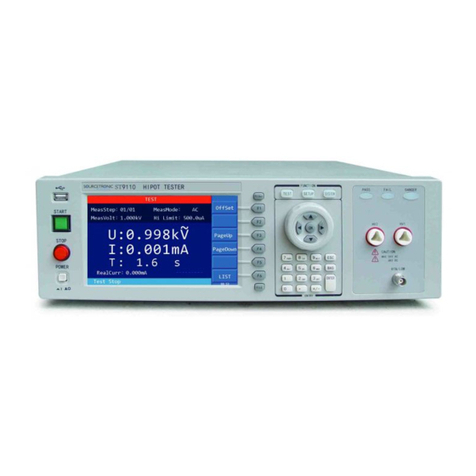
Sourcetronic
Sourcetronic ST9110/A User manual
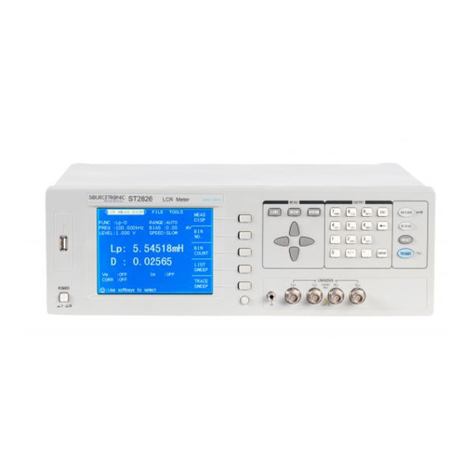
Sourcetronic
Sourcetronic ST2826 User manual
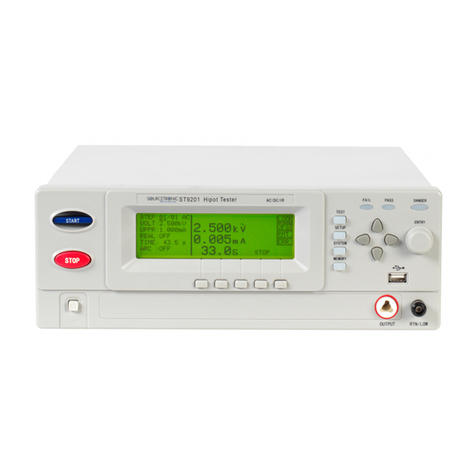
Sourcetronic
Sourcetronic ST9201 Series User manual
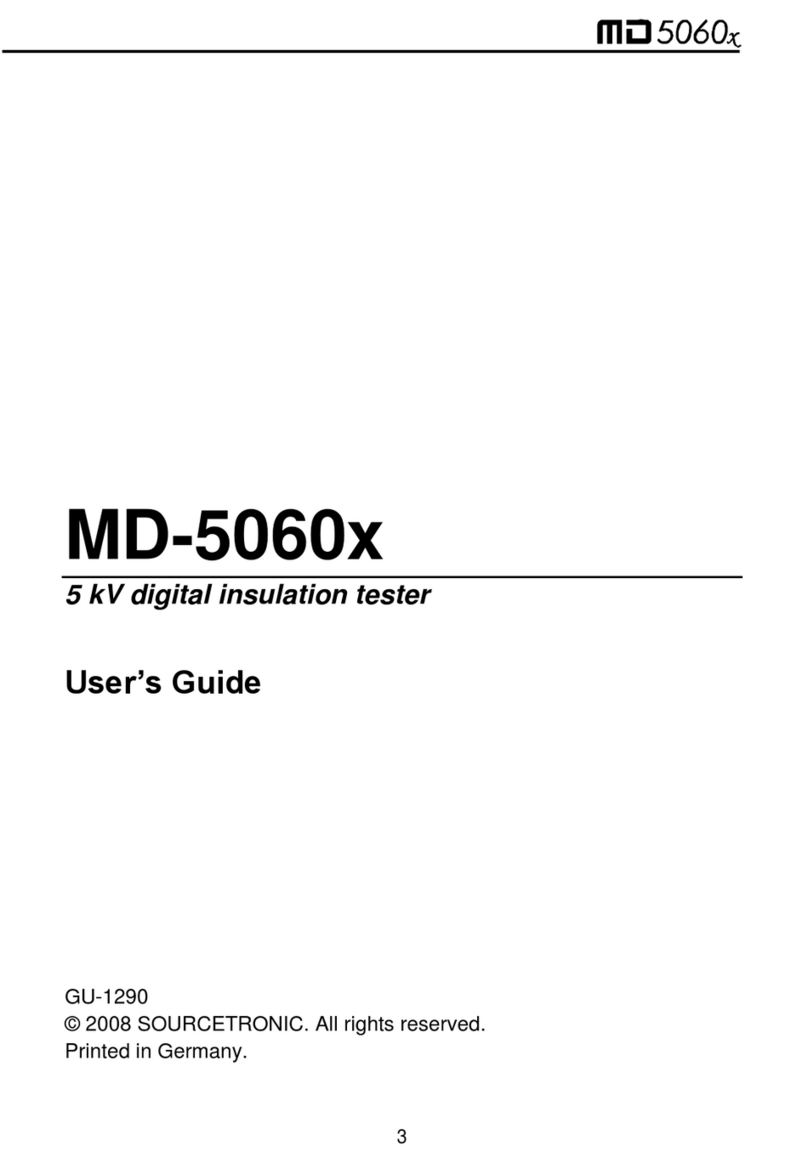
Sourcetronic
Sourcetronic MD-5060 Series User manual
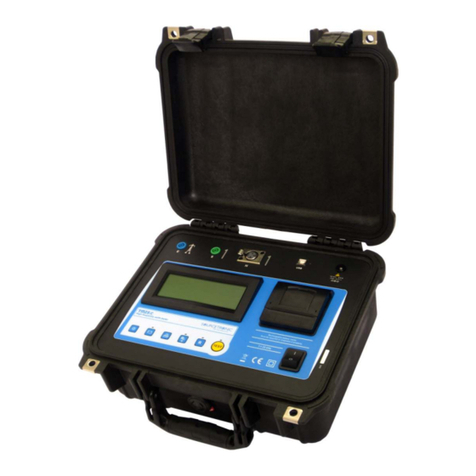
Sourcetronic
Sourcetronic TM-25R User manual
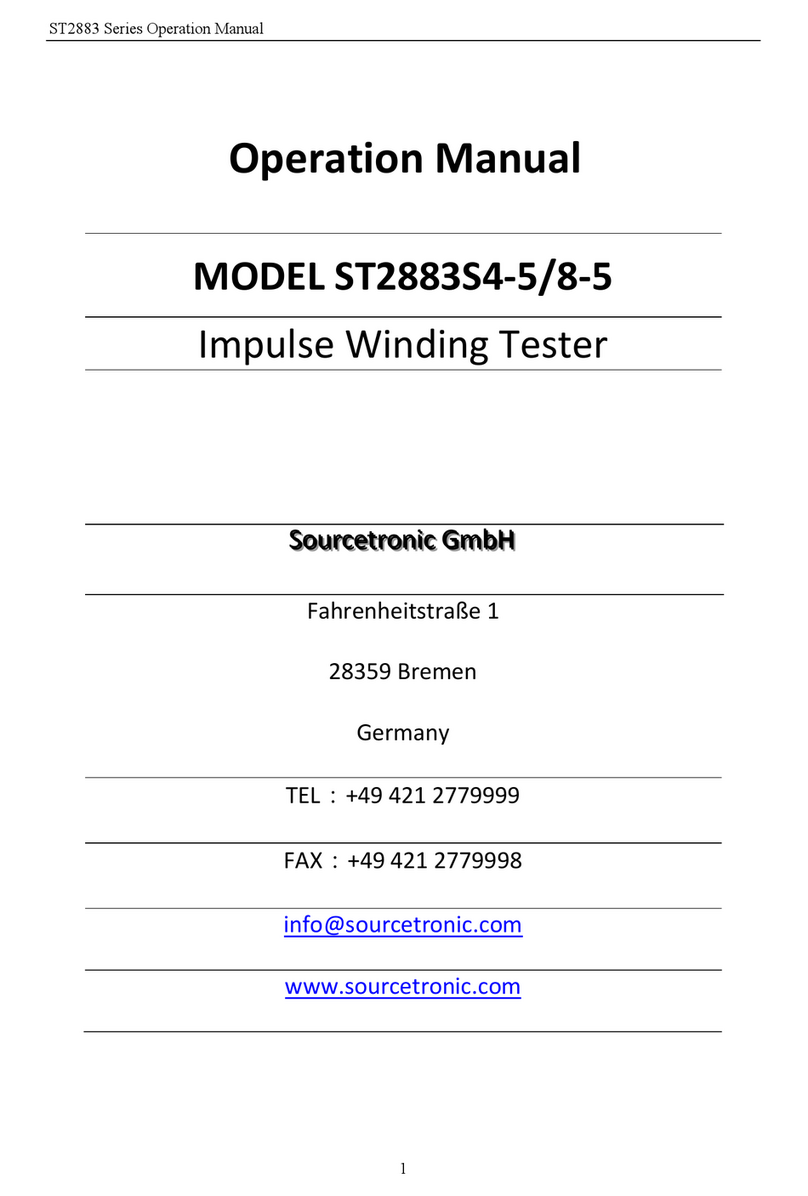
Sourcetronic
Sourcetronic ST2883 Series User manual
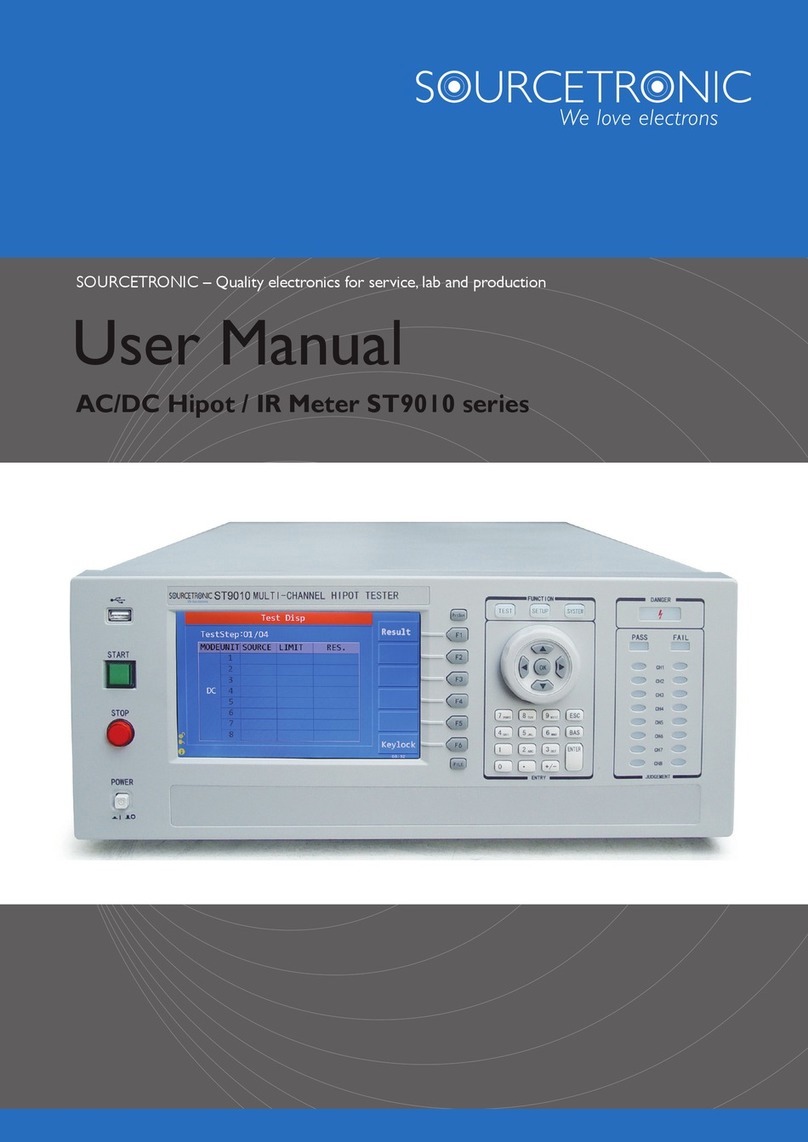
Sourcetronic
Sourcetronic ST9010 Series User manual
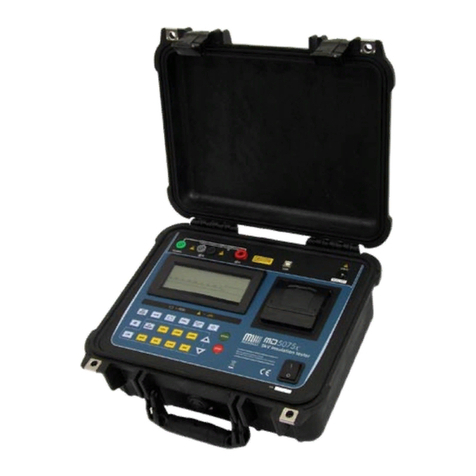
Sourcetronic
Sourcetronic MD-5075 Series User manual
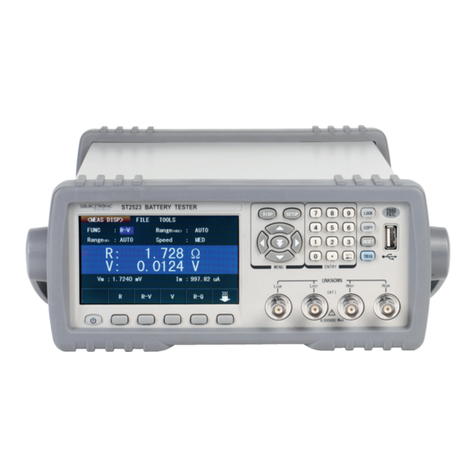
Sourcetronic
Sourcetronic ST2523 User manual
